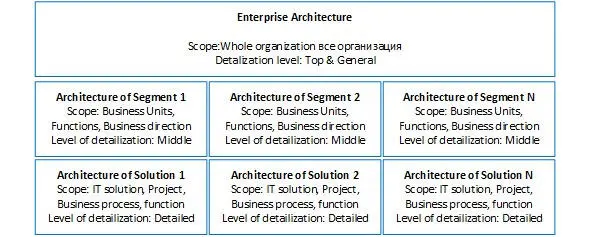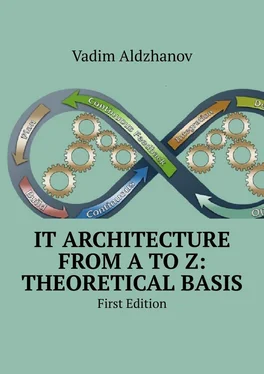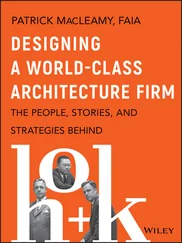•Application architecture shows the business applications deployed in the company, their interaction and relationship with the company’s business processes.
•Data architecture contains a description of the logical and physical structure of the company’s data, as well as the approach and means of data management.
•Technical architecture describes the software and equipment required to deploy business services, data and applications, IT infrastructure, application servers, networks, telecommunications, standards, etc.

“Enterprise Architecture documentation level”
The next level of hierarchy can be:
•Strategic architecture – describes the entire company. At this level, you are not immersed in the peculiarities of specific departments, business areas, etc. The strategic architecture focuses on the company’s overall strategies, business processes, investments, data, systems and technologies. Its primary focus is the implementation of the company’s strategy. At this level, principles and priorities are defined, the common IT services are created for the whole company.
• Segment architecture is the architecture of the company’s activities, the program of projects or a separate subdivision. The company will have several segments like this. At this level, you are immersed in the peculiarities and requirements of a particular subdivision, function, or company within an organization. You study the IT business case with departmental leadership. The segment architecture should have the same structure and shared services as the strategic architecture does.
• Solution architecture is the architecture of a specific IT solution. It is used to implement new or adjust the current IT solutions, services or their parts. It considers both the common requirements for the entire company and the specific needs identified at the segment architecture level. The solution architecture is limited to a single project, process, or function. The solution architecture is studies in the most thorough way. It allows avoiding unpleasant surprises in the future as the project is implemented.
In the organization grows and develops, the IT department also goes through several stages of its development. Building an Enterprise Architecture one should take into account the maturity level of the entire organization and IT in particular. The following stages and symptoms of the IT department state can be distinguished:
Initial or “localization”
The company rapidly develops or purchases information systems that give value to a particular business unit or function. The main symptoms of this stage of development are:
• IT department is secondary;
• No IT department strategy;
• No IT department budget;
• IT department acts upon request only;
• Managerial staff is concerned in maximum savings;
• Service within the business department (administration, finance) in the organizational structure of the company.
Development or “standardization”
The company moves from closure of the needs of individual business units or functions and increases IT efficiency by standardizing technology and infrastructure. The main symptoms of this stage of development: are:
• The IT department is not a strategic resource;
• No or initial level of IT department strategy;
• No IT department budget or it is managed by the third party;
• IT department hardly acts in IT infrastructure or acts passively (upon request only);
• Managerial staff is concerned in minimum investment;
• Service or department within the business unit (administration, finance) or overseen position in the organizational structure of the company.
Establishment or “optimization”
The company builds end-to-end business processes using common data and information systems. Whenever possible, it centralizes subdivisions’ business processes and functions in centralized information systems according to previously described operational models. The main symptoms of this stage of development are:
• The IT department is important;
• IT department strategy partially meets business requirements;
• Manageable IT department budget;
• IT department responses reactively to business requirements;
• Managerial staff is concerned in getting business benefits in the short term;
• A dedicated department in the organizational structure of the company, but the IT manager is not a part of the board of directors.
Mature
Reuse of existing business processes and components to create new services and opportunities. Proactive IT is an integral part of the business. The main symptoms of this stage of development are:
• The IT department is a strategic organization resource;
• IT department strategy integrated into the company’s business strategy;
• IT department budget considered as business investment;
• IT department acts proactively to business requirements;
• Managerial staff is concerned in long-term business investment;
• IT department is a part of the company’s organizational structure, CIO is a member of the board of directors.
Each of these stages has pros and cons. The IT development stage should correspond to that of the company. Experience has shown that to skip at least one of the stages is difficult since it requires huge amounts of resources (time, money, human resources etc.), and the effect will rather be to the contrary. Most companies grow stage-by-stage. The company transits to the next stage when the leadership of the company realizes or the severity of the issues arisen:
• Issues of supporting the growth and business changes
• Duplication of business processes
• Multiple platforms and systems
• Dissatisfaction with the current IT state.
Criteria of choosing a methodology
Since the methodologies vary a lot, one should set criteria to compare them.
The completeness of the taxonomy defines the suitability degree of the methodology for the classification of various architectural artifacts or whether fully focused on the Zachman framework.
The completeness of the process defines how detailed the process of creating the enterprise architecture is.
The guide to reference models defines the usefulness of the methodology in creating an adequate set of reference models. The FEA methodology is almost entirely focused on this.
The practical guide defines the degree of implementation of the speculative idea of the enterprise architecture by the methodology and shaping the culture in which this architecture will be used. The Gartner methodology is almost entirely focused on this.
The readiness model defines the degree of assessment of the efficiency of using the enterprise architecture in various departments by the methodology.
A business orientation defines whether a methodology focused on using technology to increase business value, where business value defined as cost reduction or revenue increase.
The management guide defines the degree of methodology usefulness in understanding and creating an effective management model for an enterprise architecture.
The partitioning guide defines the usefulness of the methodology in effective partitioning the enterprise into departments, which is very important in managing complexity.
The availability of the catalog defines the efficiency of the methodology to create a catalog of architectural assets to be used in the future.
Читать дальше













